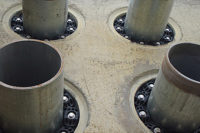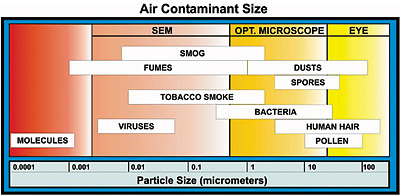
Building owners, managers, designers, and maintenance personnel need reliable information about filtration options, such as: what types of air filtration systems are effective for various CBR agents; what types of air filtration systems can be implemented in an existing HVAC system; what types of air filtration systems can be incorporated into existing buildings when they undergo renovation; and how to properly maintain the air filtration systems installed in a building.
Proper air filtration combined with other protective measures can reduce the risk and mitigate the consequences of a CBR attack. Measures outlined in this article also provide the side benefits of improved HVAC performance - increased building cleanliness, limited effects from accidental releases, and generally improved IAQ.
Air filtration systems can remove a variety of contaminants from a building's airborne environment. The effectiveness of a particular type of filter or air cleaning media will depend upon the nature of the contaminant.
In this article, air filtration refers to removal of aerosol contaminants from the air, while air cleaning refers to the removal of gases or vapors from the air. The focus of this article is air filtration. Airborne contaminants will be gases, vapors, or aerosols (small solid and liquid particles). It is important to realize that sorbents collect gases and vapors, but not aerosols; conversely, particulate filters remove aerosols, but not gases and vapors. The ability of a given sorbent to remove a contaminant depends upon the characteristics of the specific gas or vapor and other related factors. The efficiency of a particulate filter to remove aerosols depends upon the size of the particles, in combination with the type of filter used and HVAC operating conditions. Larger-sized aerosols can be collected on lower-efficiency filters, but the effective removal of a small-sized aerosol requires a higher-efficiency filter.
CBR agents may travel in the air as a gas or an aerosol. Most chemical warfare agents are gaseous, while biological and radiological agents are largely aerosols. Figure 1 shows a diagram of the relative sizes of common air contaminants (e.g., tobacco smoke, pollen, dust). These agents could enter a building through either an internal or external release. Some health consequences from CBR agents are immediate, while others may take much longer. CBR agents can enter the body through a number of routes including inhalation, skin absorption, contact with eyes or mucous membranes, and ingestion. The amount of an agent required to cause symptoms varies among agents; in general, they are much more toxic than common indoor air pollutants.
Simply stated, filtration removes unwanted aerosols from an airstream. Particulate air filters are classified as either mechanical filters or electrostatic filters (electrostatically enhanced filters). Although they perform differently, both types of filters are fibrous media and are used extensively in HVAC systems to remove particles, including biological materials, from the air. Four different collection mechanisms govern particulate air filter performance: inertial impaction, interception, diffusion, (all mechanical) and electrostatic attraction (Figures 2 and 3). Electrostatic filters contain electrostatically enhanced fibers, to attract particles to the fibers and retain them.
Air filters are commonly described and rated based upon their collection efficiency, pressure drop (or airflow resistance), and particulate-holding capacity. Two filter test methods are currently used in the U.S.:
- ASHRAE Standard 52.1-1992
- ASHRAE Standard 52.2-1999 (Table 1)
Filter manufacturers typically use one of these tests to describe the performance of their filters. Standard 52.2-1999 is a newer test, and newer models of filters tend to be rated with this test.
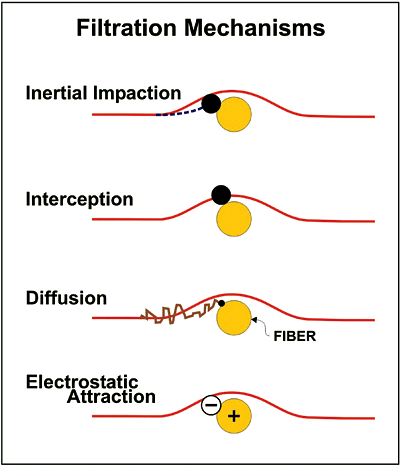
Recommendations
Before selecting a filtration strategy that includes a potential upgrade in response to perceived threats, develop an understanding of your building and its HVAC system. Assess how your HVAC system is designed and intended to operate and compare that to how it currently operates. In large buildings, this evaluation is likely to involve many different AHUs and system components.Initially, you will need to answer several questions, many difficult to answer without the assistance of qualified professionals (security, engineers, industrial hygienists, etc.) to help with threat, ventilation/filtration, and IAQ assessments. The answers to these questions, however, will guide you in making your decisions about what types of filters should be installed in your HVAC system, how efficient those filters must be, and what procedures you should develop to maintain the system. No single, off-the-shelf system can be installed in all buildings to protect against all CBR agents; some components may be used in a large number of buildings. Systems should be designed on a case-by-case basis for each building and application. Some of the important questions to ask include:
It is important to recognize that improving building protection is not an all or nothing proposition. Because many CBR agents are extremely toxic, high contaminant removal efficiencies are needed; however, many complex factors can influence the human impact of a CBR release (agent toxicity, physical and chemical properties, concentration, wind conditions, means of delivery, release location, etc.) Incremental improvements to the removal efficiency of a filtration system will likely incrementally reduce the impact of a CBR attack to a building environment and its occupants while generally improving IAQ.

Particulate Filter Selection, Installation, Use, and Upgrades
Consider system performance, filter efficiencies, and particle size. HVAC filters are critical system components. During selection, keep their importance in mind when thinking about filtration efficiency, flow rate, and pressure drop. Base your particulate filter selection on air contaminant sizes, ASHRAE filter efficiency, and performance of the entire filtration system (Table 1 and Figure 4). Filter banks often consist of two or more sets of filters; consider how the entire filtration system will perform - not just a single filter. The first filters may be low-efficiency prefilters, which remove larger particles and debris. Subsequent filters will be higher efficiency filters capable of removing smaller particles. Particles in the 0.1- to 0.3-mm size range are the most difficult to remove from the airstream and require high-efficiency filters.Chemical and biological aerosol dispersions are frequently in the 1- to 10-mm range, and HEPA filters provide efficiencies greater than 99.9999% in that particle size range, assuming there is no leakage around the filter. This high level of filtration efficiency provides protection against most aerosol threats. Chemical aerosols removed by particulate filters include tear gases and low-volatility nerve agents, such as VX; however, a vapor component of these agents could still exist. Biological agents and radioactive particulates are efficiently removed by HEPA filters.
Understand performance differences between filter types. When selecting particulate air filters, you must choose between mechanical or electrostatic filters. Remember the differences between these two filter classifications, such as collection mechanism and pressure drop differences. Liquid aerosols are known to dramatically reduce collection efficiencies in many types of electrostatic filters, and some studies have shown that ambient aerosols may also degrade performance. Pressure drop in an electrostatic filter (having less packing density) generally increases at a much slower rate than that of a similar efficiency mechanical filter.
Pressure drop is frequently used in mechanical filters to determine filter changeout, but it is an unreliable indicator for electrostatic filters. Other measures, such as collection efficiency or time in use, are more suited for electrostatic filter changeout schedules. While electrostatic filters may be acceptable for some building protection applications, recognize that there may be some limitations and compromises associated with these filters.
Consider total life cycle costs. Total life cycle costs (energy costs, maintenance, disposal, replacement, etc.) are more than just the initial purchase price. You can minimize total cost by selecting the optimum changeout schedule based on filter life and power requirements (Figure 5). Multiple filters can extend the life of the more expensive, high-efficiency filters. For example, one (or more) low-efficiency prefilter, installed upstream of a HEPA filter, can extend the HEPA filter life by at least 25%. If the disposable filter is followed by a 90% extended surface filter, the life of the HEPA filter can be extended by almost 900%1.
However, do not assume that it is always best to use a prefilter. First, weigh the cost of prefilter replacement and pressure drop against the extended life of the primary filter. You may find that for the same overall efficiency, it is more cost-effective to avoid prefilters and, instead, to change the primary filters more frequently. Make this decision by weighing the operating costs against the capture efficiencies provided by different systems.
Consider all of the elements affected by filter upgrades. Upgrading your filtration system may require significant changes in the mechanical components of your HVAC system, depending upon the component capacities. Consider both the direct and indirect impact of upgrading your filtration system. With lower-efficiency filters, the final (loaded or dirty) pressure drop is often in the range of 125 to 250 Pascals (Pa) (0.5 to 1.0 in. w.g.). Higher efficiency filters may have an initial pressure drop higher than this, with a final pressure drop of as high as 325 Pa (1.5 in. w.g.). Many systems do not have the fan capacity to handle the higher pressure drop associated with higher-efficiency filters. If the pressure drop of the filters installed in the system is too high, the HVAC system may be unable to deliver the designed volume of air to the occupied spaces.
Higher capacity fans may be needed to overcome the increased resistance caused by higher efficiency filters. Installation of such fans may not be feasible for many HVAC systems due to space limitations. In such cases, extended surface filters (e.g., pleated, mini-pleated, or V-bank) or electrostatic filter media, with higher efficiencies and low pressure drops, may be an alternative. To be most effective, your filters should be used at their rated pressure drop and face velocity (the velocity of the airstream entering the filter).
Conduct periodic quantitative performance evaluations. You should use a quantitative evaluation to determine the total system efficiency. You should perform the evaluation for various particle sizes and at the appropriate system flow rate. You can use your evaluation of the results to implement further modifications (e.g., improved filter seals). Information on quantitative evaluations of HVAC system and filter performance can be found in the ASHRAE Handbook - Systems and Equipment and the NAFA Guide to Air Filtration.
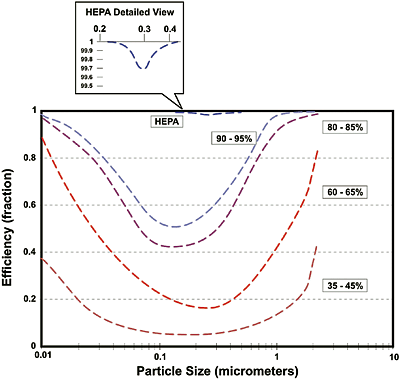
A Word about Filter Bypass and Air Infiltration
Ideally, all airflow should pass through the installed filters of the HVAC system. However, filter bypass occurs when air flows around a filter or through some other unintended path. Preventing filter bypass becomes more important as filter collection efficiency and pressure drop increase. Filter bypass can result from various imperfections such as poorly sealed filters. Filters can be held in place with a clamping mechanism, but this method may not provide an airtight seal. The best high-efficiency filtration systems have gaskets and clamps that provide an airtight seal. Any deteriorating or distorted gaskets should be replaced and checked for leaks. You can visually inspect filters for major leakage around the edges by placing a light source behind the filter; however, the best method of checking for leaks involves a particle counter or aerosol photometer.
Another issue to consider is infiltration of outdoor air into the building. Air infiltration may occur through openings in the building envelope - such as doors, windows, ventilation openings, and cracks. Typical office buildings are quite porous and may have leakage rates ranging from 0.03 to 0.6 m3/min per m2 of floor space (0.1 to 2 cfm/sq ft), at pressures of 50 Pa (0.2 in. w.g.).2 To achieve the most effective filtration system against external CBR threats, you must minimize outdoor air leakage into your building. Dramatically reducing leakage may be impractical for many older buildings, which may have large leakage areas, operable windows, and decentralized HVAC systems.
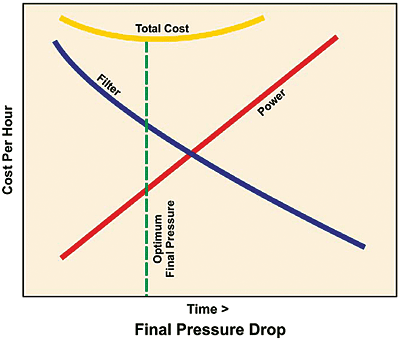
Recommendations Regarding O&M
Filter performance depends on proper selection, installation, operation, testing, and maintenance. The scheduled maintenance program should include procedures for installation, removal, and disposal of filter media. Only adequately trained personnel should perform filter maintenance and only while the HVAC system is not operating (locked out/tagged out) to prevent contaminants from being entrained into the moving airstream.Understand how filter type affects changeout schedules. Proper maintenance, including your monitoring of filter efficiency and system integrity, is critical to ensuring HVAC systems operate as intended. The changeout schedule for various filter types may be significantly different. One difference is the little change in pressure drop occurring during the loading of an electrostatic filter, as opposed to mechanical filters. Ideally, you should determine the changeout schedule for electrostatic filters by using optical particle counters or other quantitative measures of collection efficiency, optimizing electrostatic filter life and filtration performance. The data should be particle-size selective so that you can determine filtration efficiencies that are based on particle size (e.g., micrometer, sub-micrometer, and most penetrating size).
Mechanical filters, however, show larger pressure drop increases during loading, and hence, pressure drop can be used to determine their appropriate changeout schedules. With mechanical filters, a manometer or other pressure-sensing device should be installed to provide an accurate and objective means of determining the need for filter replacement. Pressure drop characteristics of both mechanical and electrostatic filters are supplied by the filter manufacturer.
Ensure maintenance personnel are well trained. Qualified individuals should be responsible for the operation of the HVAC system. Maintenance personnel must have a general working knowledge of the HVAC system and its function. They are responsible for monitoring and maintaining the system, including filter changeout schedules, documentation, and recordkeeping, and therefore, should be involved in the selection of the appropriate filter media for a given application. Persons performing maintenance and filter replacement on any ventilation system that is likely to be contaminated with hazardous CBR agents should wear appropriate personal protective equipment (respirators, gloves, etc.) in accordance with Occupational Safety and Health Administration (OSHA) Standards Code of Federal Regulations (CFR) 1910.132 and 1910.134. Because of the sensitive nature of these systems, appropriate background checks should be completed and assessed for any personnel who have access to the HVAC equipment.
Handle filters with care and inspect for damage. Mechanical filters, often made of glass fibers, are relatively delicate and should be handled carefully to avoid damage. Filters enclosed in metal frames are heavy and may cause problems because of the additional weight they place on the filter racks. The increased weight may require a new filter support system that has vertical stiffeners and better sealing properties to ensure total system integrity. Polymeric electrostatic filters are more durable and less prone to damage than mechanical filters.
Check all filters for damage before installing them and visually inspect the seams for total integrity. Hold the filters in front of a light source and look for voids, tears, or gaps in the filter media and filter frames. Take special care to avoid jarring or dropping the filter element during inspection, installation, or removal.


